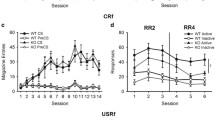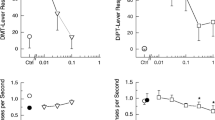Abstract
m-Chlorophenylpiperazine (mCPP), a major metabolite of the atypical antidepressant trazadone, has been observed to produce marked physiological and behavioral effects in both humans and animals. These effects have been attributed to the interaction of mCPP with serotonergic receptors. The present study was designed to characterize those interactions of mCPP with central serotonergic receptors which mediate mCPP-induced stimulus control. A series of serotonergic antagonists (mesulergine, pizotyline, ketanserin, spiperone, risperidone, ritanserin, metergoline, pirenpirone, and LY53857) was tested for the ability to block the mCPP stimulus. The affinity of these antagonists for 5-HT2A and 5-HT2C receptors was then correlated with maximal percent inhibition of the mCPP stimulus. Kd at the 5-HT2C receptor was inversely proportional (r=−0.75,P<0.05), and Kd at the 5-HT2A receptor directly proportional (r=+0.67,P<0.05) to the maximal percent inhibition of the mCPP stimulus. The 5-HT2C selectivity ratio [Kd(5-HT2A)/Kd(5-HT2C)] of the antagonists was directly proportional (r=+0.86,P<0.01) to maximal percent inhibition of the mCPP stimulus. A multiple regressions analysis indicated that 81% of the variance in the ability of a given antagonist to block the mCPP stimulus could be predicted on the basis of its affinity for 5-HT2A and 5-HT2C receptors. It is concluded that the stimulus effects of mCPP are mediated predominantly by a combination of agonist activity at 5-HT2C receptors and antagonist activity at 5-HT2A receptors.
Similar content being viewed by others
References
Ator NA, Griffiths RR (1989) Asymmetrical cross-generalization in drug discrimination with lorazepam and pentobarbital training conditions. Drug Dev Res 16:355–364
Bagdy G, Szemeredi K, Kenyicska B, Murphy DL (1989a) Different serotonin receptors mediate blood-pressure, heart rate, plasma catecholamine and prolactin responses tom-chlorophenylpiperazine in conscious rats. J Pharmacol Exp Ther 250:72–78
Bagdy G, Calogero AE, Murphy DL, Szemeredi K (1989b) Serotonin agonists cause parallel activation of the sympathoadrenomedullary system and the hypothalamo-pituitary-adrenocortical axis in conscious rats. Endocrinology 125:2664–2669
Balster RL (1990) Perception of drug effects. In: Berkeley MA, Stebbins WG (eds) Comparative perception, vol 1: basic mechanisms. Wiley, N.Y. pp 127–154
Brady JV, Hienz RD, Ator NA (1990) Stimulus functions of drugs and the assessmet of abuse liability. Drug Res Dev 20:231–249
Caccia S, Ballabio M, Samanin R, Zanini MG, Gavattini S (1981) (-)mCPP, a central 5-hydroxytrypatamine agonist, is a metabolite of trazadone. J Pharm Pharmacol 33:477–478
Caccia S, Fung MH, Gavattini S, Zanini MG (1982) Plasma concentrations of trazadone and 1-(3-chlorophenyl)piperazine in man after a single oral dose of trazadone. J Pharm Pharmacol 34:605–606
Callahan PM, Cunningham KA (1994) Involvement of 5-HT2C receptors in mediating the discriminative stimulus properties ofm-chlorophenylpiperazine (mCPP) Eur J Pharmacol 257:27–38
Canton H, Laurence V, Colpaert FC (1990) Binding of typical and atypical antipsychotics to 5-HT1C and 5-HT2 sites: clozapine potently interacts with 5-HT1C sites. Eur J Pharm 191:93–96
Carver JG, Grahame-Smith DG, Johnson ES, Madgwick Z (1992) The effects of 5-HT andm-chlorophenylpiperazine (mCPP) on the efflux of [3H]5-HT from human perfused platelets. Br J Clin Pharmacol 35:473–478
Charney PS, Woods SW, Goodman WK, Heninger GR (1987) Serotonin function in anxiety II: Effects of the serotonin agonist mCPP in panic disorder patients and healthy subjects. Psychopharmacology 92:14–24
Cohen ML, Fuller RW (1983) Antagonism of vascular serotonin receptors by m-chlorophenylpiperazine andm-trifluoromethylphenylpiperazine. Life Sci 32:711–718
Colpaert FC (1990) Drug discrimination: methods of manipulation, measurement and analysis. In: Bozarth MA (ed) Methods of assessing the reinforcing properties of abused drugs. Springer, Berlin pp 341–372
Conn PJ, Sanders-Bush E (1985) Serotonin stimulated phosphoinositide turnover: mediation by the S2 binding site in rat cerebral cortex, but not subcortical regions. J Pharmacol Exp Ther 234:195–203
Conn PJ, Sanders-Bush E (1986) Agonist-induced phosphoinositide hydrolysis in rat choroid plexus. J Neurochem 47:1754–1769
Conn PJ, Sanders-Bush E (1987) Relative efficacies of piperazines at the phosphoinositide hydrolysis-linked serotonergic 5-HT1C and 5-HT2 receptors. J Pharmacol Exp Ther 242:552–557
Friedman RL, Barrett RJ, Sanders-Bush E (1984) Discriminative stimulus properties of quipazine: mediation by serotonin2 binding sites. J Pharmacol Exp Ther 228:628–634
Fuller RW, Snoddy HD, Mason MR, Owens JE (1981) Disposition and pharmacological effects ofm-chlorophenylpiperazine in rats. Neuropharmacology 20:155–162
Glennon RA, Rosecrans JA, Young R (1982) The use of the drug discrimination paradigm for studying hallucinogenic agents. In: Colpaert FC, Slangen JL (eds) Drug discrimination: applications in CNS pharmacology. Elsevier Biomedical Press, Amsterdam, pp 69–96
Glennon RA, Rosecrans JA, Young R (1984) Drug-induced discrimination: a description of the paradigm and a review of its specific application to the study of hallucinogenic agents. Med Res Rev 3:289–376
Hamick A, Peroutka SJ (1989) 1-(m-Chloro-phenyl)piperazine interactions with neurotransmitters in the human brain. Biol Psychiatry 25:569–575
Hoenicke EM, Vanacek SA, Woods JH (1992) The discriminative stimulus effects of clozapine in pigeons: involvement of 5-HT1C and 5-HT2 receptors. J Pharmacol Exp Ther 263:276–284
Hollander E, Decaria C, Gully R (1991) Effects of chronic fluoxetine treatment on behavioral and neuroendocrine responses tom-chlorophenylpiperazine in obsessive-compulsive disorder. Psychiatry Res 36:1–17
Hoyer D (1988) Functional correlates of serotonin 5-HT1recognition sites. J Recept Res 8:59–81
Hoyer D, Waeber C, Schoeffter P, Palacios JM, Dravid A (1989) 5-HT1C receptor mediated stimulation of inositol phosphate production in pig choroid plexus. Naunyn-Schmiedeberg's Arch Pharmacol 339:225–238
Hoyer D, Schoeffter P, Sahin-Erdemli I (1991) Competitive antagonism by recognized 5-HT2 receptor antagonists at 5-HT1C receptors in pig choroid plexus. Naunyn-Schmiedeberg's Arch Pharmacol 344:137–142
Hoyer D, Clarke DE, Fozard JR, Hartig PR, Martin GR, Mylecharane EJ, Saxena PR, Humphrey PA (1994) International union of pharmacology classification of receptors for 5-hydroxytryptamine (serotonin). Pharmacol Rev 46:157–203
Hulihan-Giblin BA, Park YD, Goldman D, Aulakh CS (1993) Analysis of the 5-HT1C receptor and the serotonin uptake site in Fawn-Hooded rat brain. Eur J Pharmacol 239:99–102
Iqbal N, Asnis GM, Wetzler S, Kahn RS, Van Praag HM (1991) The mCPP challenge test in schizophrenia: humoral and behavioral responses. Biol Psychiatry 30:770–778
Johnson RG, Fiorella D, Rabin RA (1993) Effects of chronic cocaine administration on the serotonergic system in rat brain. Pharmacol Biochem Behav 46:289–293
Julius DJ, Macdermott AB, Axel R, Jessell JM (1988) Molecular characterization of a functional cDNA encoding the serotonin1C receptor. Science 241:558–564
Kahn RS, Wetzler S (1991)m-Chlorophenylpiperazine as a probe of serotonin function. Biol Psychiatry 30:1139–1166
Kahn RS, Wetzler S, Van Praag, Asnis GM, Strauman T (1988) Behavioral indications for serotonin receptor hypersensitivity in panic disorder. Psychiatry Res 25:101–104
Kahn RS, Kalus O, Cahn W, Wetzler S, Asnis GM, Van Praag HM (1990) The effect of 5-HT antagonists onm-chlorophenylpiperazine mediated responses. Psychiatry Res 33:189–198
Kalus O, Kahn RS, Wetzler S, Asnis GM, Van Praag HM (1991) Behavioral hypersensitivity tom-chlorophenylpiperazine in a subject with subclinical panic attacks. Biol Psychiatry 28:1053–1057
Kennett GA, Curzon G (1988) Evidence that mCPP may have behavioral effects mediated by central 5-HT1C receptors. Br J Pharmacol 94:137–147
Kennett GA, Curzon G (1991) Potencies of antagonists indicate that 5-HT1C receptors mediate 1-3(chlorophenyl)piperazine induced hypophagia. Br J Pharmacol 103:2016–2020
Krystal JH, Seibyl JP, Lawrence HP, Woods SW, Heninger GR, Aghajanian GK, Charney DS (1993)m-Chlorophenylpiperazine effects in neuroleptic free schizophrenic patients. Arch Gen Psychiatry 50:624–635
Lucki I, Ward HR, Frazer A (1989) Effect of 1-(m-chlorophenyl) piperazine and 1-(m-trifluoromethylphenyl)piperazine on locomotor activity. JPharmacol Exp Ther 249:155–164
Murphy DL, Lesch KP, Aulakh CS, Pigott TA (1991) Serotoninselective arylpiperazines with neuroendocrine, temperature, and cardiovascular effects in humans. Pharmacol Rev 43:527–552
Nelson DL, Herbert A, Bergoin G, Glowinski J, Haman M (1978) Characteristics of central 5-HT receptors and their adaptive changes following intracerebral 5,7-dihydroxytryptamine administration in the rat. Mol Pharmacol 14:983–995
Prichett DB, Bach AW, Wozny M, Talab O, Taso RD, Shih JC, Seeberg PH (1988) Structure and functional expression of the cloned rat serotonin 5-HT1C receptors in choroid plexus. EMBO J 7:4135–4140
Sanders-Bush E, Breeding M (1988) Putative selective 5-HT2antagonists block serotonin 5-HT1C receptors in choroid plexus. J Pharmacol Exp Ther 247:169–173
Sanders-Bush E, Conn PJ (1988) LSD and 2,5-dimethoxy-4-methylamphetamine are partial agonists at serotonin receptors linked to PI hydrolysis. J Pharmacol Exp Ther 246:924–928
Van Wijngaarden I, Tulp M Th M, Soudijn W (1990) The concept of selectivity in 5-HT research. Eur J Pharmacol 179:357–366
Winter JC (1978) Drug-induced stimulus control. In: Blackman D, Sanger J (eds) Contemporary research in behavioral pharmacology. Plenum Press, N.Y., pp 341–372
Winter JC (1994) The stimulus effects of serotonergic hallucinogens in animals. In: Lin GC (ed) Hallucinogens, an update. NIDA Monograph, US Government Printing Office 146:157–182
Winter JC, Rabin RA (1993) Discriminative stimulus properties ofm-chloropiperazine. Pharmacol Biochem Behav 45:221–223
Zohar J, Meuller EA, Insel TR, Zohar-Kadouch RC, Murphy DL (1987) Serotonergic responsivity in obsessive-compulsive disorder: comparison of patients and healthy controls. Arch Gen Psychiatry 44:946–951
Author information
Authors and Affiliations
Additional information
This study was supported in part by U.S. Public Health Service grant DA 03385 (J.C.W., R.A.R.), by National Research Service Award MH 10567 (D.F.), and by a fellowship from Schering-Plough Research Institute (D.F.). Animals used in these studies were maintained in accordance with the “Guide for Care and Use of Laboratory Animals” of the Institute of Laboratory Animal Resources, National Research Council.
Rights and permissions
About this article
Cite this article
Fiorella, D., Rabin, R.A. & Winter, J.C. The role of the 5-HT2A and 5-HT2C receptors in the stimulus effects ofm-chlorophenylpiperazine. Psychopharmacology 119, 222–230 (1995). https://doi.org/10.1007/BF02246164
Received:
Revised:
Issue Date:
DOI: https://doi.org/10.1007/BF02246164




